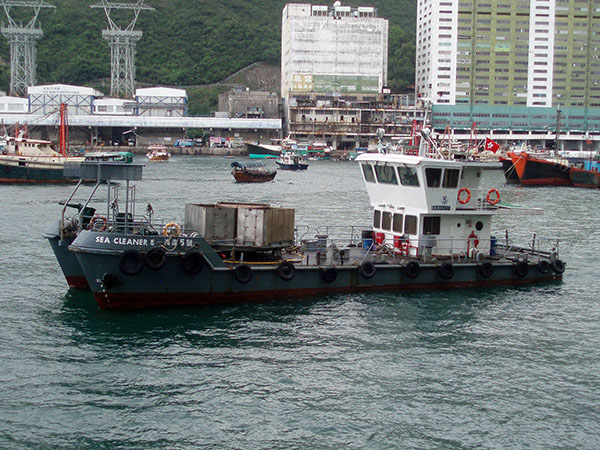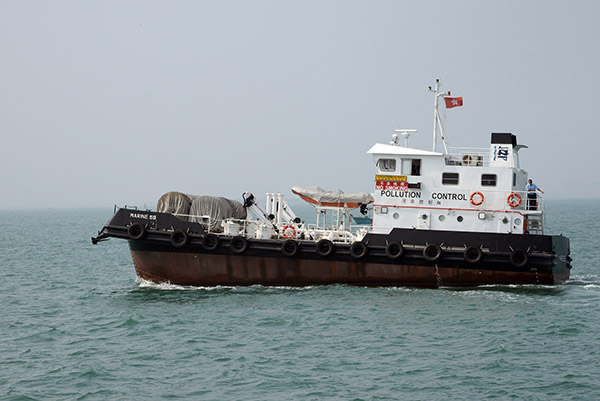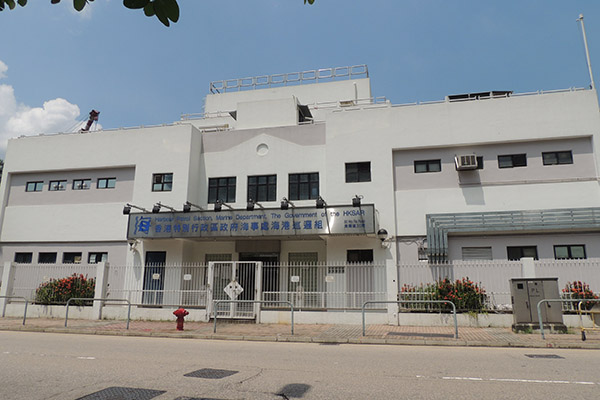Pollution Control Unit: outsourcing for greater cost-efficiency
The Pollution Control Unit underwent a great change in 2005. Before that, marine refuse collection and scavenging services were performed partly by private contractors and partly by using government resources. Five contractors provided scavenging boats and workers to perform marine refuse cleansing services in designated regions or districts, whilst the Marine Department deployed in-house staff to operate purpose-built Sea Cleaner Class scavenging vessels to clean up marine refuse in other parts of Hong Kong waters. Both in-house resources and outsourcing were adopted at the same time for the provision of services.
After 2005, the Marine Department decided to fully outsource marine cleansing services and adopted performance-based specifications for monitoring the performance of contractors, including the introduction of the “cleanliness index” for performance measurement. The reformed outsourcing arrangement bundled previous small contracts into two large contracts to cover the whole Hong Kong waters and leased the government-owned Sea Cleaner Class scavenging vessels to the contractors. The staff of the Marine Department is responsible for monitoring the contractors’ work to ensure that performance standards are fully met.
In 2005 the Marine Department also outsourced marine oil pollution cleansing services to a privately run oil spill response company. The contractor was required to provide oil pollution control vessels and skilled workers to handle Level One (less than 500 tonnes) oil spills. For Level Two (between 500 to 2,000 tonnes) and Level Three (over 2,000 tonnes) oil spill incidents, assistance from the private sector and/or overseas oil spill response organisations would be required.
To meet the requirements of the Protocol on Preparedness, Response and Co-operation to Pollution Incidents by Hazardous and Noxious Substances, 2000, the Maritime Hazardous and Noxious Substances (HNS) Spill Response Plan came into effect in October 2011. Under the Plan, the Marine Department Pollution Control Unit has been tasked with cleaning up the treated residues of HNS in water.
The Regional Maritime Oil Spill Response Plan for the Pearl River Estuary was developed in accordance with the International Convention on Oil Pollution Preparedness, Response and Cooperation, 1990. In September 2008, the authorised representatives of the Hong Kong Marine Department, the Guangdong Maritime Safety Administration, the Shenzhen Maritime Safety Administration and the Macao Maritime Administration signed the “Pearl River Estuary Regional Maritime Oil Spill from Ship Response Co-operative Arrangement”, under which they agreed to adopt the Regional Response Plan as an operational guideline for handling major maritime oil spills in the Pearl River Estuary region. They further agreed to co-operate in response actions and resource-sharing.
Harbour Patrol Section: from “unit” to “section”
Established in April 1997, the Harbour Patrol Section was initially located at the Yau Ma Tei Marine Office. Its function was to maintain shipping and port safety by controlling and harmonising the activities of shipping and other marine operations within Hong Kong waters. It assumed the role of the then Harbour Services Patrol Unit and the various marine offices in relation to the control of river trade and local vessels.[7]
With the new section set up, the operational efficiency of the Marine Department’s harbor patrol service was greatly improved through placing the patrol launches under a unified command. The departmental patrol section oversaw the regional patrol functions of various district marine offices, effectively deployed the patrol launches and related staff resources, and promoted co-operation and communication among the district patrol units.
The newly established section was also able to regulate shipping more effectively and respond more promptly to marine accidents through the more flexible deployment of vessels.
To promote marine safety, the Harbour Patrol Section held the first Navigational Safety Seminar in 2005, and has been organising Navigational Safety Seminars and Safety Afloat Seminars annually since January 2006.
The Operation Centre of the Harbour Patrol Section was upgraded to a Command Centre in April 2011. The operating hours of the centre were then extended to cover the period between 0700 hours on Saturdays to 0700 hours on Mondays. With the further strengthening of manpower, the Harbour Patrol Section Command Centre began operating all year round in April 2013.
Public Cargo Working Areas: areas contracted out
Management reform
In 1996, in order to introduce an open, fair and economically viable system for the allocation of berths in public cargo-working areas (PCWAs), the Marine Department proposed to reform the management of PCWAs by phases. While berths had been allocated before 1998 on a first-come-first-served basis under a permit system, the berths were since then allocated through restricted tender to operators by fixed-term agreements. Unallocated berths were then distributed by open tender, and re-tendering was carried out to re-allocate the PCWA berths upon the expiry of the relevant agreements. With the first tendering exercise taking place at the end of 1997, berths were allocated for a term of three years and the monthly fee was adjusted annually. The term was extended to five years in the tendering exercise of 2011.
In 1999, an Operating Area Permit system was introduced to replace the host of permits required for landside activities. The permit allowed a berth tenant, through payment of a monthly fee, to use the working apron adjacent to the berth.
Operation
Operators can rent the land area of the PCWA adjacent to their berths for handling cargoes. They may set up container offices, rest shelters and mobile shore cranes; use fork-lift trucks for cargo stacking; depositing cargoes; and carrying out other activities related to cargo handling, without paying additional fees after obtaining the Operating Area Permit.
Various types of cargo are handled by different operators in the PCWAs. Operators can be broadly grouped into five categories according to the major types of cargo they handled: outlying island trade, general cargo, recyclable materials, bulk materials and containers. Dirty cargoes such as waste paper, sand, gravel and cement are handled at certain specified berths.
Due to a lack of interest in their berths, the Chai Wan PCWA and the Sheung Wan PCWA were closed after the first tender exercise in 1997. In 2003, the Marine Department re-opened the Chai Wan PCWA to relocate operators displaced by the closure of the Wan Chai PCWA due to the Central and Wan Chai Reclamation Project. In 2011, the Kwun Tong and Cha Kwo Ling PCWAs were closed for the South East Kowloon Development, leaving six PCWAs (Western District, Stonecutters Island, Chai Wan, Rambler Channel, Tuen Mun and New Yau Ma Tei) in operation.
Notes:
- [7]Marine Department Notice No. 58 of 1997, 27 March 1997.
Part 1 Chapter 8.2 - Development of the Marine Department: Enhancement and innovation





